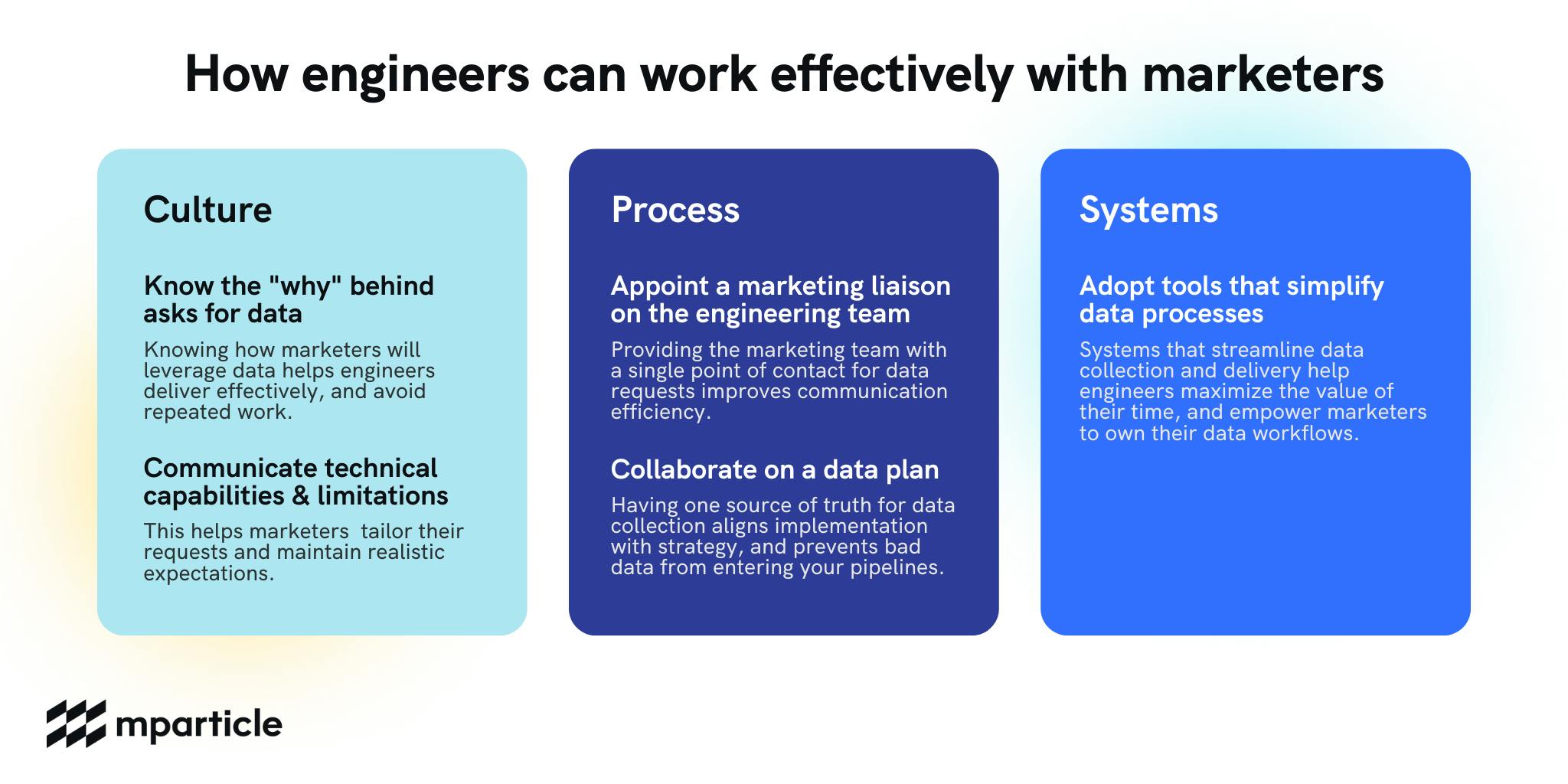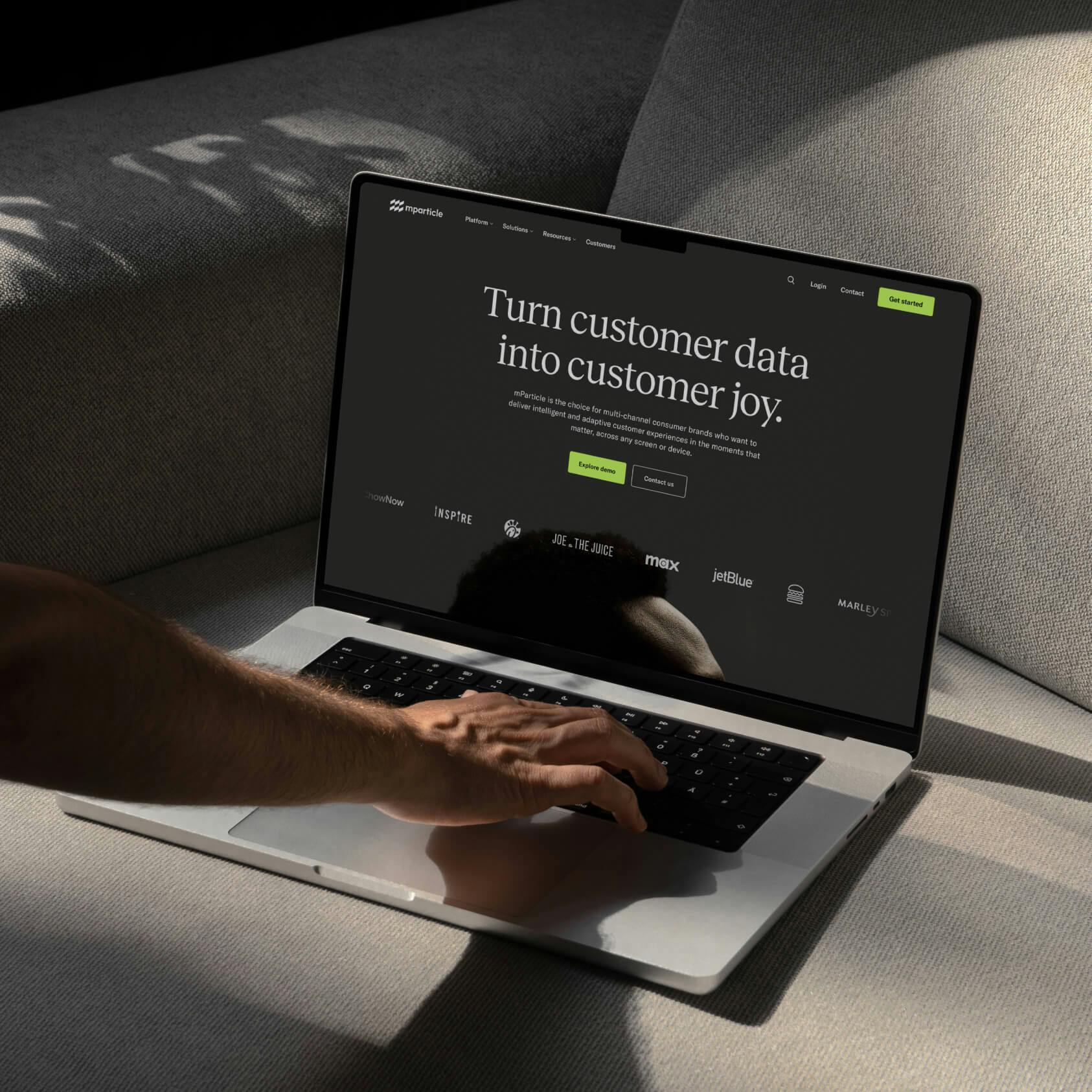The engineer’s guide to working with marketers
While developers don’t readily admit it, working with marketers can sometimes be a pain. But when engineers and marketers collaborate effectively on data, amazing things can happen. We’ve assembled this guide to provide engineers with a roadmap for effectively working with their colleagues in marketing and making friends out of frenemies.

Developers, we get it. For the most part, you appreciate your colleagues in the marketing department. They’re nice folks––warm, friendly, and engaging, albeit a little too much so sometimes––and they always seem to be having the best hangouts and happy hours. You like them as humans, you really do. It’s just that sometimes, well… sometimes they get in your way. Sometimes they ask you for things that divert time away from your core responsibilities.
Often, these requests have to do with data––collecting it from your apps and websites, querying it to create audiences for campaigns, or delivering it to some new tool for customer engagement. You know in your mind that these objectives are important to the business. But nonetheless, these asks are a bit annoying. They pull time away from building features and smashing bugs––the things that made you want to learn to code in the first place. Your team lead doesn’t care how many engagement tools you implemented for the marketing team. She cares about your next PR––you know, the one you’ll submit right after you get this slice of data over to the marketing team.
As irksome as it may be to have to deliver on these marketing requests, know this: The marketer asking you for that new integration or dataset is probably just as fed up as you are. They need your help to unlock the data that will allow them to drive growth, personalize customer experiences, win new customers, decrease churn, and do lots of other things that will help bring the awesome products you build to a wider audience. While this moment may sometimes create tension, the result of the work will benefit both parties greatly.
When engineers and marketers view these data workflows as opportunities rather than hindrances, both teams win. In fact, the whole company wins. No single resource is capable of driving an organization’s growth more effectively than data, and the combination of skills that engineering and marketing teams possess is a recipe for leveraging this asset for all it’s worth.
We wanted to take a pulse on how engineering and marketing teams currently collaborate on data. In an online poll of engineers, this is what we found:

Among the subset of engineers who reported that they work with engineers on data (75%), it is slightly more common for marketing and engineering teams to collaborate than to treat this workflow as a one-way street. This indicates that a good number of organizations treat data as a team sport, which is encouraging. However, it’s clear that many companies could still benefit from rethinking the nature of the relationship between engineers and marketers. To that end, the rest of this article will lay out a blueprint that engineering teams can follow to transform this partnership, and leverage the respective knowledge and skills of both teams to unlock opportunities for growth.
But first, let’s start with some basics.
What is marketing, and why do marketers exist?
As an engineer, you probably have a very clear idea of what your product does on a technical level. You know what makes it faster, more flexible, and more intuitive to users than other products on the market. While your product wouldn’t be great without your team thinking through all these nuts-and-bolts details, this alone will not attract users and grow your company. This is where marketing comes in. In order to accomplish these goals, here are some things your marketing team has to do well:
Understand your customers
What problems are your users trying to solve when they purchase your product or download your app? What are their personal values, and what resonates with them emotionally? These are just some of the things your marketers need to understand about your consumers in order to effectively drive growth.
Tell the story of your company and product
Once your marketing team has these insights, they can begin to craft narratives around your product and reach your customers with personalized communication rather than than generic, one-size-fits-all messaging.
Deliver the right message at the right time
Once your marketing team is armed with blog posts, emails, digital ads, landing pages, website copy and a plethora of other assets tailored to your customers, they still need to deliver these messages on the right channels, and at the right time.
Streamline your website integrations
Learn which third-party integrations you could replace with a single SDK by adopting mParticle.

Okay fine. But why do they keep asking for stuff?
Think about the last point above––delivering the right message at the right time. This is the most critical aspect of the marketing team’s job, since without reaching customers effectively, all of that strategizing and messaging would be meaningless. In today’s world, consumers are constantly receiving messaging from a variety of channels at all times. Cutting through this noise requires precise targeting and follow-up with prospects, and this hinges on one thing: data. While some modern marketing platforms allow for a certain amount of no-code data enablement, generally speaking, marketers are going to need help from engineers on three main fronts:
Integrating and maintaining systems
Marketers use different platforms to accomplish different things––for example, they might leverage one tool for delivering and managing social ad campaigns, another for CRM, and yet another for personalization and engagement. Unless you’re leveraging a tool to serve as a single access point to collect all of your customer data and deliver it to multiple systems, app developers will need to implement each downstream system’s native SDKs and APIs individually.
Querying, transforming, and delivering datasets
Targeting customers precisely requires finely tuned datasets. When the data that marketers need does not live in a format or structure that can be ingested by activation systems, data engineers need to perform the necessary queries and transformations to reshape and deliver this data.
Developing a single view of the customer
Your customers more than likely interact with your brand on a variety of different channels, like web, iOS and Android applications (and quite possibly several others). In order to target customers effectively, marketers need events collected across different sources to be combined into a unified view of the customers who generated them. This requires a complex process called identity resolution. Unless engineering teams are leveraging a data infrastructure tool like a CDP that delivers this capability, data engineers need to build and maintain this ID resolution internally.
Get content like this, without leaving your inbox
Stay up-to-date with relevant industry reads and product news by subscribing to the mPulse monthly newsletter.

Building a fruitful, sustainable partnership between engineers and marketers
Hopefully this has given you some insight into the minds of your marketing friends that you didn’t have before. Understanding why these marketers keep asking you for integrations and datasets is important to servicing their requests as efficiently as possible. To take this one step further, however, this knowledge can also help you to build cross-functional and collaborative processes around data, and unlock use cases that would never come to light through a simple ask-and-receive workflow.
To that end, here are five concrete steps that engineers can take to work more effectively with marketing teams, broken out into three main categories: culture, process, and systems.

Know the “why” behind the ask
Understanding the full context around the marketing team’s requests––what they plan to do with a new system once it’s integrated, or how they will use that slice of data they’re asking for—will pay dividends. Having this information will decrease the likelihood of misunderstanding their request and eventually having to repeat the work. Additionally, this knowledge can help you anticipate future needs the marketing team may have, and build automated processes to handle these when they arise.
Make marketers aware of technical capabilities and limitations
When you don’t spend your life under the hood of software products, you’re blissfully unaware of the work it takes to get things to work the way they do. Buttons just click, elements on a webpage just scale, and resources just load when you want them to (usually, at least). So when marketers want to track data events along a user journey, it might not occur to them that collecting data on certain actions might require hacky workarounds because of the way your interface is built. When they ask for a specific audience to target in a campaign, they might not realize that producing that dataset will require joining tables from three different locations. By making marketers aware of these limitations, you can manage their expectations as far as delivery times, and help them tailor their requests more closely to what is technically feasible.
Process: Establish an owner and begin collaborating
Appoint a marketing liaison on the engineering team
When technical solutions teams work with clients, they typically appoint one main point of contact per client in order to maintain a clear line of communication. Since each client has a unique situation and complex needs, it’s usually best to have one individual who stays well-versed in all of the technical specifics relevant to the account. Your marketing team is not unlike one of your company’s clients. In fact, they are the customers of your company’s data product. They work with complex systems, and their goals and objectives change over time. When they approach your team with a request, it will be much easier to interpret and fulfill their need if one engineer has the complete picture of why they’re coming to you.
Maintain a data plan, and collaborate with marketing on creating and maintaining it
Once you begin collecting data events in various places throughout your apps and websites, it can become difficult to keep track of which events are implemented where, how these data points are structured, and what business objectives these data points will help deliver on. Maintaining a data plan as a central source of truth on your data strategy and implementation is a great way to prevent the chaos that can ensue once your data practice begins to scale. This document can serve as a way for your marketing liaison to translate the marketing team’s high-level needs into the technical specifics required to implement data collection, and provide both teams with a resource for knowing the current state of data implementation.
Systems: Adopt new tools to offload repetitive work
Adopt tools that simplify data processes
Abraham Lincoln once said, “If I only had an hour to chop down a tree, I would spend the first 45 minutes sharpening my axe.” If Honest Abe were a software engineer, we can be pretty sure he wouldn’t waste his time on repetitive data collection and transformation processes when he could offload these workflows to infrastructural tools. Integrating new marketing vendor APIs and SDKs into your apps takes time and effort, as does repeatedly querying a database to retrieve custom audiences for the marketing team. If you find that these workflows are becoming unsustainable, you would be well served to explore the landscape of customer data infrastructure solutions that can simplify data collection and transformation. A tool like a CDP, for instance, not only provides a single access point for all of your customer data, but also enables marketers to add new integrations and control the flow of data to downstream systems without requiring your support.
Taking the next step
Perhaps your organization is right on the cusp of the ”systems” phase above. You have the right people and processes in place, and collaboration between marketers and engineers is generally productive and cohesive. However, you still find that even with this well-oiled machine, data requests remain a heavy load for your engineering team to manage. You might benefit from mParticle by:
- Define customer events once and reuse them across your data stack
- Reduce the number of SDKs in your app to improve performance
- Seamlessly create and implement data plans
- Spend less time shipping data to marketers



